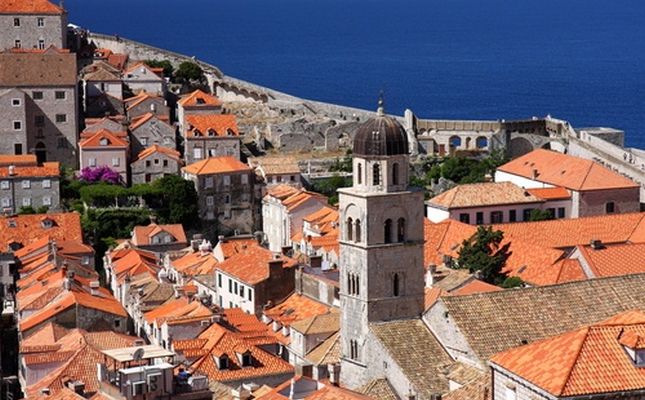[fshow photosetid=72157629781141322]
When I was younger, maybe 9 or 10 years of age, I went on my first my cruise ship, departing from Venice with port calls in a few Greek and Croatian destinations. At that age, to be dragged off the ship by eager parents every day, only to be rushed through the town and return to the boat mere hours later, was not my idea of a holiday. Perhaps it was the age, one at which culture and historical sights hadn’t yet registered on my interest radar. The cruise had multiple swimming pools, a 24-hour snack bar to which my brother and I made many surreptitious midnight snack runs, and a kid’s club with fun activities.
Beyond the beach
I recall getting whiny at our last port of call. Prior to that we’d gotten off quite a few Greek islands, and without any knowledge context, one beach is only as good as the last. “You must,” reprimanded the evil parents, “this is our last destination”. So eventually, I dragged my coveted new sneakers (high-tops, at their peak of coolness) all the way down the plank. On the atlas, Croatia looked close to Greece, and I was expecting more of the same. But Dubrovnik was different. Images of a seaside walled medieval town pulled up references of Disney castles, and even though we had only a few hours to walk through the city, I knew one day I’d return to explore more of the country.
Re-discovering Dubrovnik
That was my first and last trip on a cruise. On a tour of Europe years later, I decided to pick just 2 countries and experience as many different sides of their cultures as I could in 1 month. My journey started with a base in Dubrovnik. After hastily checking into the hotel, I retraced my childhood walk along the city’s 2 kilometer long wall with the intention of scoping out the lay of the land. The stroll along the historic fortress only took 15 minutes, with the late afternoon sun sprinkling a golden dust atop the tight cluster of orange tiled roofs and on the surface of the ocean just beyond. The city was smaller than I remembered, but then again, everything seems big when you’re little.
Instead of wandering aimlessly through the streets, I decided to book a walking tour with my cousin for the day after, keeping one day as a jet-lag buffer. Walking is by far my favorite way to experience a city, especially in small town centers – that’s the best way to hear, smell, and feel the city, with the option of stopping whenever something catches your eye. The private tour worked out to about 80 Euros per person, not the cheapest, but preferable to ambling through the city looking down on our iPhones and following a city app.
A walk through Croatian history
At 8am on the day, we headed to the hotel lobby to meet up with our guide. The city crash-course walk was to last over 3 hours, so we donned our comfortable sneakers (low-tops this time) to take to the streets. Milos was standing in the lobby, waiting. We identified ourselves, exchanged greetings, and spent the rest of the morning being shown around Dubrovnik. The main sites we saw (read: multiple stops to take photos with our iPhone free hands) included the gothic Rector’s Palace, a former center of the Dubrovnik Republic, which now houses a museum showcasing the the history of the city, and plenty more.
Milos peppered our walk throughout the morning with pertinent trivia – in the instance of the Rector’s Palace, telling tales of earthquakes, fires, rebuilt staircases, Baroque and Renaissance additions to the palace made along the years. We visited the Dubvronik Cathedral, where he pointed out statues, identified altars, and of course, more history, and the intriguing Franciscan Monastery, which, among other interesting facts, houses the oldest working pharmacy in all of Europe.
Our extended tour featured lesser trodden routes, including a detour to a local market, up and down steps, across picturesque sections of the old wall, and through meandering small cobblestoned streets, passing fountains, forts, pillars, and an anecdote to go with seemingly every man made structure. By the end of the walk, Milos had become like an old friend showing off his city, and we learned more than we can remember. Having received an overall feel of the city, we’d spend the next week exploring it in detail before branching out to other Croatian towns.
Of all the trivia we learned during our 3.5 hour walk, there was one that stood out as the most surprising (I guess it’s because everything else was about wars, cathedrals, very oldy worldy). Did you know? That the necktie, the modern symbol of formality, traces its roots back to 17th century soldiers in Croatia? This little known fact singlehandedly helped made choosing souvenirs for male friends and family a breeze, requiring minimal space in the luggage but with a big story to tell.
A non-profit organization, Academia Cravatica (http://academia-cravatica.hr), works on the preservation and study of the cravat as part of the country’s heritage. On their website, they have a list – purely for entertainment – of what a cravat says about the person wearing it:
- Chequered: Neatness and regularity, with larger squares suitable for comical souls
- Striped: A covert need for neatness and regularity
- Whorl: Relaxation and freedom, suitable for creative types
- Polka dots: Orderly, with small circles said to stimulate smiling

